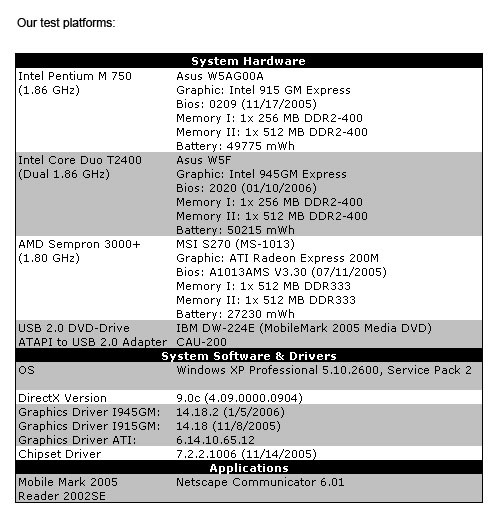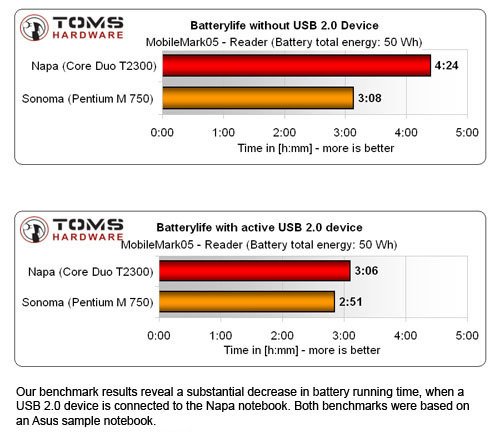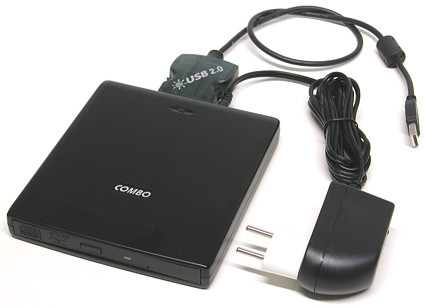Microsoft driver bug saps Core Duo power
The Benchmark: Core Duo notebook loses 76 minutes of battery time
Tom's Hardware Guide's initial comparisons used two notebook computers from the same manufacturer, using identical components but with key exceptions: The first unit used Intel's older Sonoma platform, with a single-core Pentium M 750 (1.86 GHz) processor, and a 915 GM chipset with the ICH6-M Southbridge. The second uses the new Napa platform, with a Core Duo T2400 (1.83 GHz) processor, and a 945 GM chipset with the ICH7-M Southbridge.
In our first test, Tom's engineers ran Mobilemark 2005 - Reader Benchmark on both machines, with no external USB device connected to either unit. The Sonoma unit clocked in at a running time of 3 hours, 08 minutes; the Napa registered 4 hours, 24 minutes. In ordinary circumstances, the Napa system does run 44% longer than the Sonoma system, which is well within the glowingly positive estimates provided throughout last year by Intel.
For our second test, our engineers connected a USB 2.0 external combo drive (IBM DN-224E), and ran Mobilemark 2005 - Reader Benchmark on both systems again. The external drive was powered by its own external power adapter, which means it should avoid draining any power from the system to which it's attached. To keep the USB port awake, we continuously read data from each device using a standard electricians' tool. CPU load on both notebooks, according to numbers registered by Windows Task Manager, was about 2 - 3%. Current drain on the USB port of both systems was about 170 mA, which translates into a negligible power consumption of about 1 watt.
The second test yielded the more astonishing result: While the Sonoma notebook only lost 17 minutes of battery running time (2:51 total) with the drive connected, the Core Duo notebook's running time decreased by a stunning 76 minutes (3:08 total). In short, the power drain from the device attached to the Napa system reduced running time by 347% (76 minutes / 17 minutes) of the power drain for the same device attached to the Sonoma system. With a USB device connected, the Napa notebook with the USB device connected ran only 8% longer than the Sonoma rig.
In a second battery of tests, we were able to replicate these same results for both platforms. However, our engineers aborted further tests using these two systems, after the charge regulator in our Asus W5F Napa notebook failed to work properly. We have since been unable to secure a replacement system that would meet our requirements of matching the specifications of the Sonoma system, except with the newer CPU and chipset.
Our USB 2.0 device: IBM DN-224E
Although the Napa platform notebook system used in our tests was, admittedly, a sample, it's important to note it is not what we typically understand to be a "prototype." Its contents very likely represent the technology that will soon be shipping in volume through retail channels, and which you'll soon be able to purchase for yourself. The Napa system in our tests was received by our labs two weeks after Intel's announcement of the Core Duo processor and related platform; with the official production date so close on the horizon, it is simply improbable that this system is very different from a mass production unit. Clearly, our concern was that Intel could find itself shipping a major product that contains a major problem.
Get Tom's Hardware's best news and in-depth reviews, straight to your inbox.
Current page: The Benchmark: Core Duo notebook loses 76 minutes of battery time
Prev Page Next Page The scheduler that won't stop

